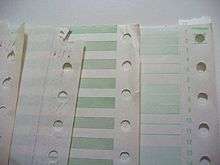Continuous stationery

Continuous stationery (UK) or continuous form paper (USA) is paper which is designed for use with dot-matrix and line printers with appropriate paper-feed mechanisms. Other names for continuous stationery include fan-fold paper, sprocket feed paper, burst paper, tractor-feed paper, and pin feed paper. It can be single-ply (usually woodfree uncoated paper) or multi-ply (either with carbon paper between the paper layers, or multiple layers of carbonless copy paper), often described as multipart stationery or forms.
Shape and form
Most continuous form paper is punched longitudinally along both edges with regularly spaced engagement holes that engage with sprocket wheels or toothed belts which move the paper through the printer. It is usually perforated transversely with a line of closely spaced holes or slits which form a tear edge that allows it to be torn neatly into separate pages after printing; when fed through the printer the paper is simply a continuous sheet.

After printing the separated sheets can be held in binders by using the sprocket holes when simply required as a record. Alternatively some types of continuous form paper also have longitudinal perforations along each edge inside the engagement holes, allowing the strips with sprocket holes to be torn off the printed page, leaving only the printable part.
The tear perforations may be short slits, which leave noticeable serrations when torn apart, acceptable for many business documents such as invoices. Where better appearance is necessary the perforations can be much finer, leaving an almost perfectly smooth edge (microperforations, microperf for short).
Continuous form paper of all types remains in production, although largely supplanted with the introduction of fast laser printers with single-sheet feed. Continuous stationery printed on a suitable printer is typically cheaper than laser printing although the output is of lower quality. If an impact printer is used multiple simultaneous copies can be printed on multipart forms. Many laser printers can print on both sides of the paper (duplex printing), not possible with continuous stationery.
Common types

The highest grade of continuous form paper uses a heavy bond weight similar to typing paper. Perforations are very small and close together, referred to as microperforations or microperf, to allow the sheets to be separated and the sprocket hole strip torn off leaving a very smooth edge almost as if guillotine-cut.[1]
The cheapest grade of continuous form paper is often preprinted with bars of light green lines across its width, to facilitate following a line of information across the page, a type commonly referred to as green bar,[2] music or music-ruled paper.[3] It is a very lightweight bond, usually without slit perforations to remove the engagement hole strips.
Common sizes:
- 241mm x 279mm (9.5in x 11in)
- 381mm x 279mm (15in x 11in)
Separation and binding

Decollator
A decollator separates multi-part continuous form paper into separate stacks of one-part continuous form paper and may also remove the carbon paper.
Burster
A burster is a machine that separates one-part continuous form paper into separate, individual, sheets along the transverse perforations. A burster was typically used with printed continuous form paper applications such as mass-mail advertising, invoices, and account statements. Bursting is done by firmly gripping the second-to-last sheet while feed rollers grip the last sheet firmly and pull it away to burst the perforation. The continuous form paper then advances into the feed rollers to burst the next sheet. Bursting is often a high-speed process that allows the continuous form paper to feed in at a steady rate, with burst pages either stacked or fed into a single-sheet conveyance to the next paper processing stage. Burster equipment and paper manufactures had to generate perforation specifications so that the paper perforations reliably separated under the force of pulling the sheets apart and not tear down into the printed part of the sheet.

Large continuous documents might not be split into separate sheets. By continuously folding two single sided printed sheets back-to-back and binding together a stack of continuous form paper along one of the folded edges, it is possible to flip through the stack like a book of double-sided printed pages. With this technique, the stack is normally flipped top to bottom or bottom to top rather than side to side.
History
This paper type was developed for use with autographic registers around 1910, was later adopted by tabulating machines beginning in the 1920s,[4] and its use grew with the introduction of commercial computers in the 1950s. IBM cards, preprinted, optionally numbered and pre-punched, were available as continuous form cards and were used for checks and other documents.[5] Continuous form paper became widely used and well known to the general public in the 1980s due to the development of microcomputers and inexpensive dot-matrix consumer printers.
Continuous form paper began to disappear from the consumer market in the 1990s as desktop publishing, and WYSIWYG document generation became more popular and widespread. Consumers were willing to pay more to get a laser printer or inkjet printer that could produce near-typeset-quality documents. These printers accept standard size cut sheets (letter, legal or A4) of paper and do not require continuous form paper. Continuous form paper continues to be used in specialty commercial and industrial markets and, as of 2013, is still available from large retailers of office supplies such as OfficeMax and Staples.
See also
Notes and references
- ↑ Paper and Printing Glossary: Microperf
- ↑ See: Evans, Christopher (1981). The Making of the Micro: A History of the Computer. VNR. ISBN 0-442-22240-8.; the first several pages of book are replicas of green bar form
- ↑ Rugby Borough Council, e-government and Information Technology strategy
- ↑ http://www.columbia.edu/acis/history/tabulator.html
- ↑ IBM (1953). Principles of IBM Accounting. 224-5527-2.
- The Free Online Dictionary of Computing
External links
- Related info at the Free On-Line Dictionary Of Computing
- Photo of a decollator in operation
- Photo of a decollator and a burster